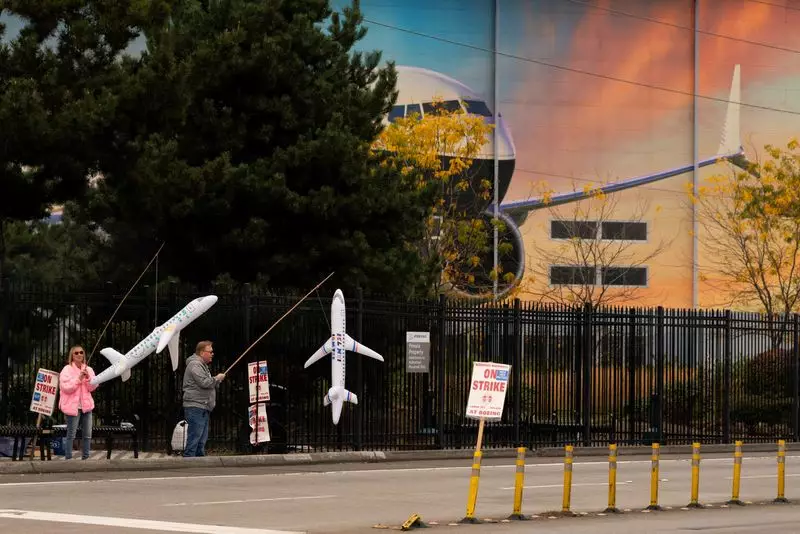Boeing, the renowned American aerospace giant, is engulfed in a tumultuous chapter marked by significant workforce reductions, unprecedented financial turmoil, and escalating production challenges. The company has announced the staggering layoff of 17,000 employees—equivalent to 10% of its global workforce—as it grapples with the ramifications of a month-long strike, delays in aircraft deliveries, and a financial landscape fraught with losses. As CEO Kelly Ortberg articulates the necessity of these downsizing strategies, the urgency for Boeing to stabilize and redefine its operational priorities has never been more palpable.
In a candid message to employees, Ortberg highlighted that these layoffs, which extend across all levels of management, are essential to recalibrating the company’s operational focus amid a stark “financial reality.” The strike, involving approximately 33,000 workers on the West Coast, has significantly disrupted production lines, particularly affecting key aircraft models, including the 737 MAX and the 777. The direct connection between ongoing labor disputes and Boeing’s financial health highlights a troubling synergy; with revenue losses amounting to $5 billion in just one quarter, the company’s struggles are far from trivial.
The company is now revising its expectations, projecting a revenue of $17.8 billion, with a loss per share that may reach $9.97. This shift in financial outlook, exacerbated by the strike, raises concerns regarding Boeing’s future operational and developmental capabilities. Thomas Hayes, an equity manager at Great Hill Capital, weighed in on the striking workers’ predicament, suggesting that financial desperation might compel workers to reach a resolution sooner rather than later.
The relationship between Boeing and its workforce has taken a critical hit as evidenced by its recent unfair-labor-practice charge against the machinists’ union. This move underscores the company’s frustration with the ongoing negotiation stalemate and introduces a contentious dynamic that could further inflame tensions between the two parties. Historical context reveals that labor relations have frequently played a pivotal role in shaping Boeing’s operational efficacy; thus, resolving this strike is crucial for regaining lost ground and mitigating operational disruptions.
Meanwhile, S&P Global Ratings has cautioned that the strike might be costing Boeing up to $1 billion monthly, and further risks could jeopardize the company’s investment-grade credit rating, placing additional pressure on its financial stability. If these trends hold, Boeing’s long-term viability could be threatened.
Strategic Decisions Amidst Declining Production Capacity
Boeing’s announcement regarding the delayed delivery of its 777X aircraft—a setback now postponed until 2026—cements the notion that the company is at a critical juncture. The struggles with certification processes and recent flight-test pauses compound the severity of these delays, pushing the company into a reactive stance rather than positioning it as a proactive leader in the aviation industry. As Ortberg conveyed, despite the current hurdles, strategic choices are being made to ensure that the company can navigate its way back to stability.
In line with these changes, Boeing has also decided to phase out its 767 freighter program by 2027, indicating a substantial shift in production priorities. While the continuation of the KC-46A tanker program demonstrates some stability, it simultaneously highlights the need for Boeing to prioritize profitable projects amid transitioning market demands.
Future Financial Strategies and the Road Ahead
The financial landscape for Boeing is rising on shaky ground, with excessive debt nearing $60 billion coupled with severe operating cash flow losses. As analysts estimate that Boeing requires an additional $10-$15 billion to maintain credit ratings, the company appears to be eyeing options for raising capital through stock sales and other securities. These maneuvers will be integral in restoring investor confidence and providing the necessary liquidity to finance ongoing operations.
In the wake of recent setbacks, Boeing faces a pivotal moment to reshape its future trajectory. The decisions made in the coming months regarding labor relations, production efficiencies, and strategic financial management will undoubtedly impact its standing within the aerospace industry. For seasoned observers, the company’s current trajectory—marked by layoffs and plummeting credit ratings—might not come as a shock, but the implications for its workforce, shareholders, and the broader market remain profound. As Boeing works to recalibrate its strategies and rebuild stakeholder trust, the tightrope walk between recovery and further decline will continue to define its path forward.

